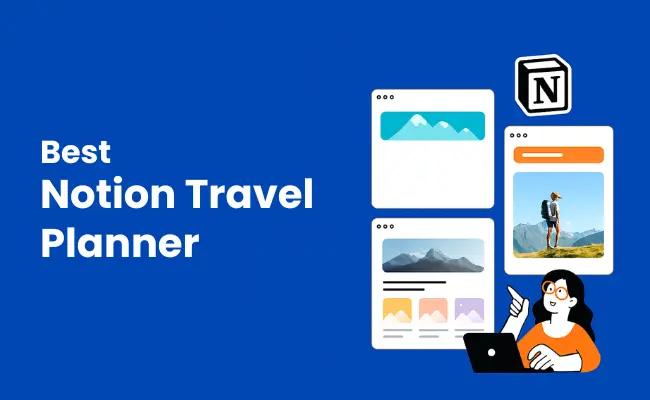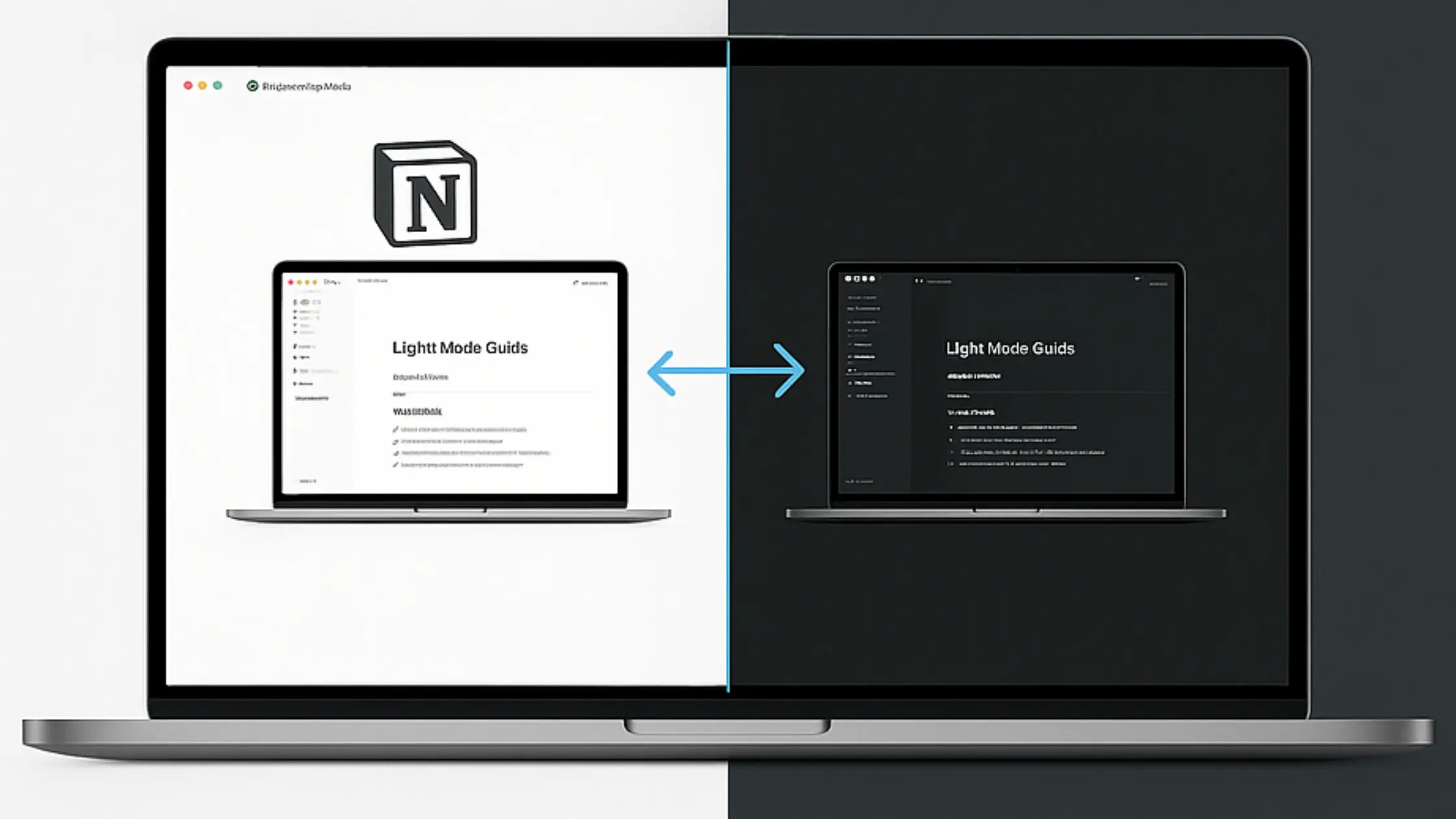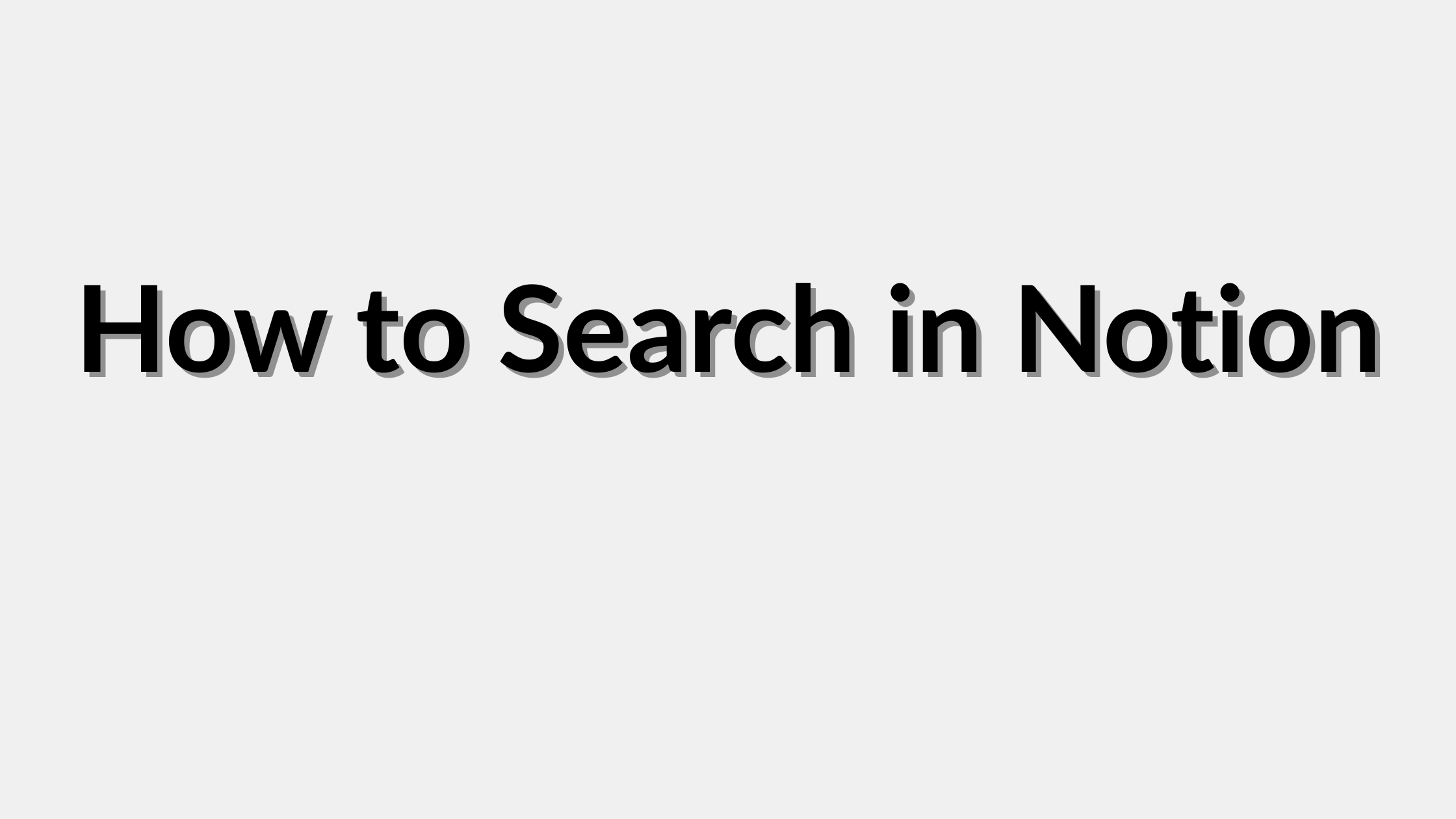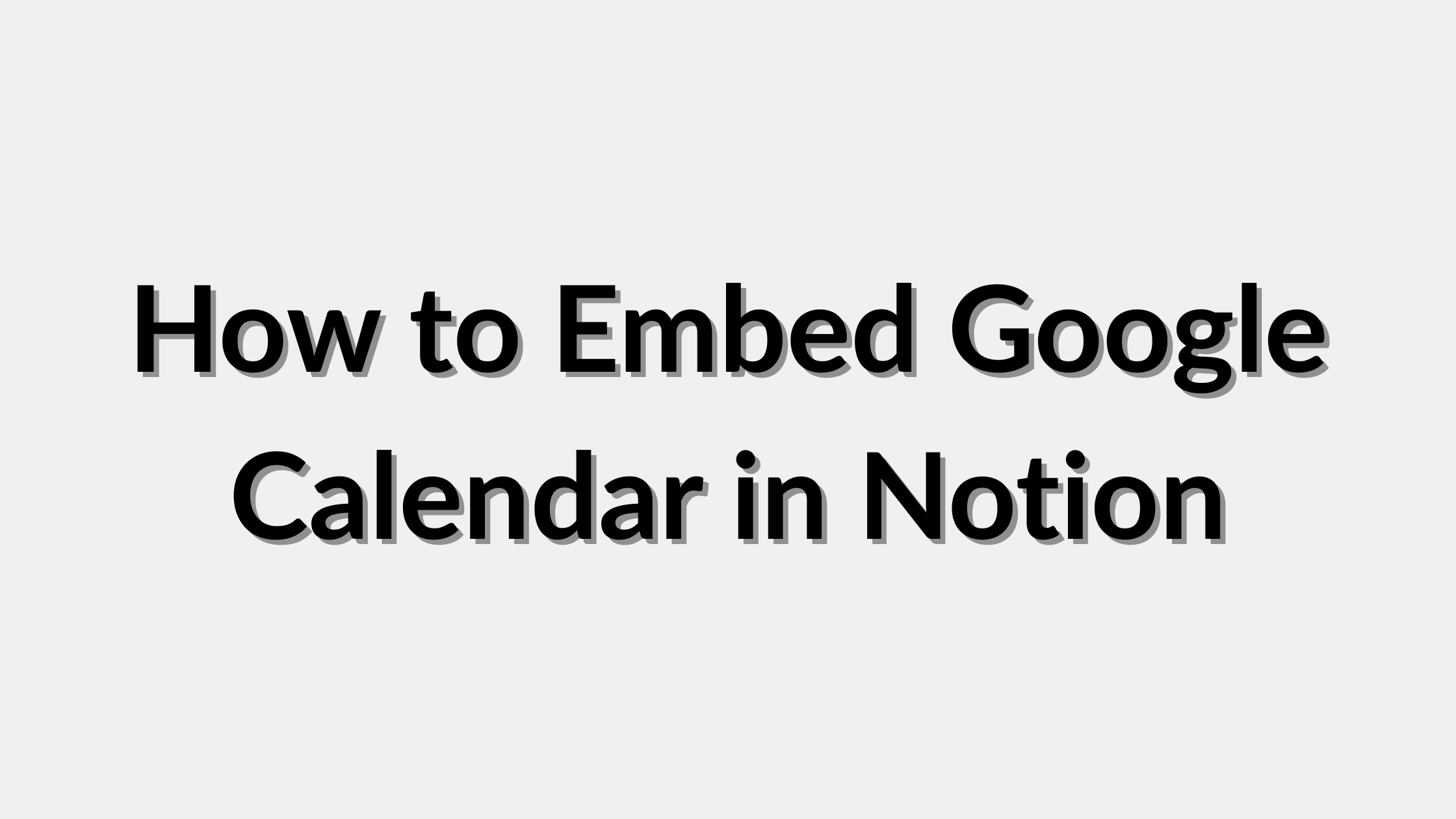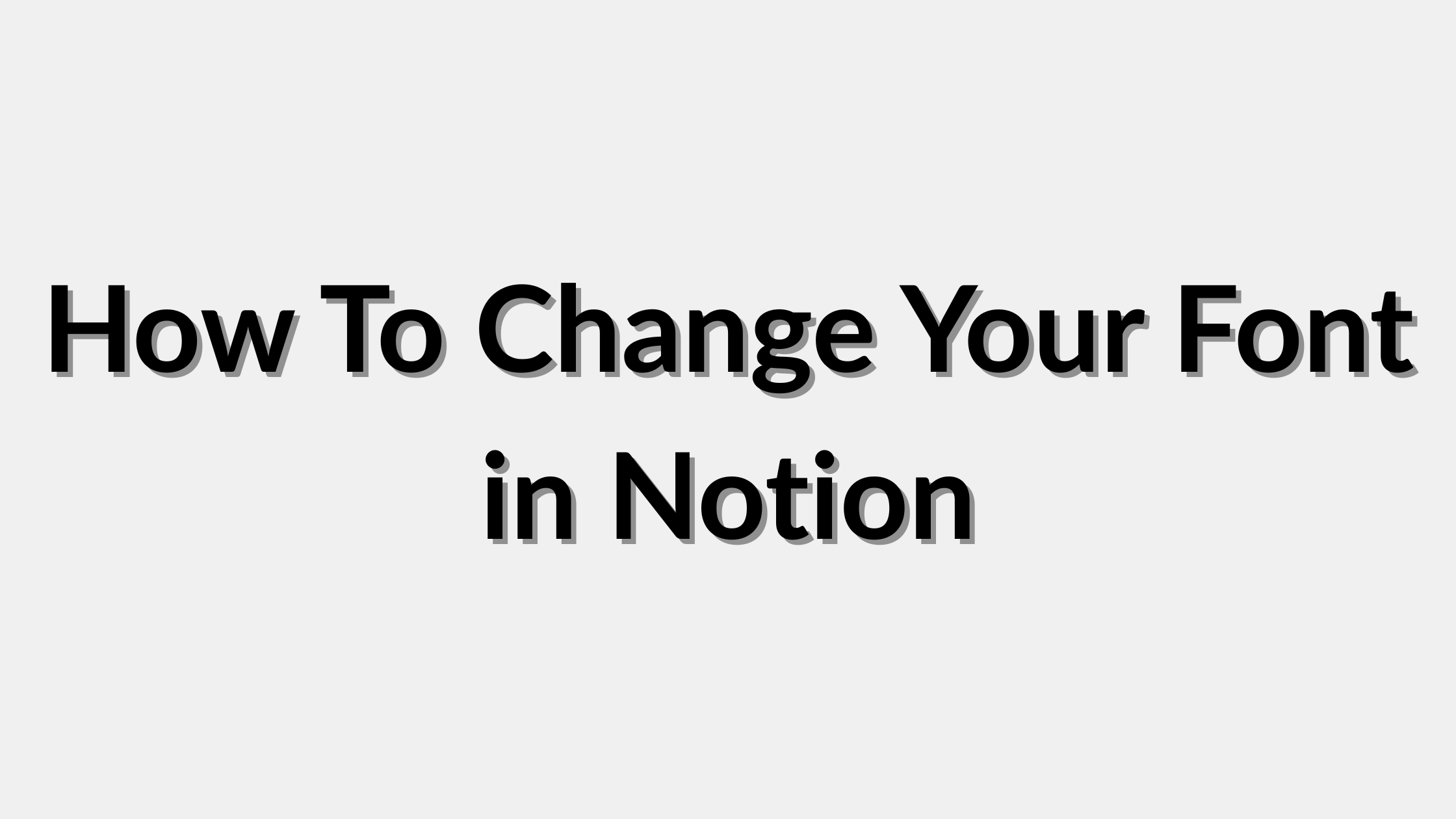Let’s face it—managing money can feel overwhelming. Whether you’re juggling student loans, side hustles, or just trying to stop impulse buying on Amazon, having the right system makes all the difference. That’s where Notion comes in.
Notion has quickly become a favorite platform for productivity lovers, and with the rise of Notion templates, it’s easier than ever to track your finances your way. From minimalist monthly planners to fully-loaded financial dashboards with investment tracking and subscription management, there’s a Notion template for every type of budgeter.
I’ve personally tested over 41 Best Notion Budget templates—paid and free—to bring you this definitive list. Whether you’re a freelancer trying to sort personal vs. business expenses, a student wanting to avoid overdraft fees, or just someone who wants to build a better relationship with money, you’ll find a template that fits.
This list covers everything:
- Powerful finance OS systems for advanced users
- Fun, visual dashboards to gamify your savings goals
- Lightweight, mobile-friendly trackers for everyday use
- Freebies that punch way above their price (aka $0!)
Each template is reviewed with real use cases—how I used them, what I loved, where I struggled, and who I think they’re best for.
So whether you’re a Notion power user or a complete beginner looking to get your financial life in order, this blog is your go-to resource. Let’s find the perfect setup that works for you—and maybe even makes budgeting a little enjoyable
Best Notion Budget Template (Premium)
1.Complete Finance Tracker
By Simo Notion

- Use Case: Comprehensive finance management
- Key Features: Expense tracking, investment monitoring, goal setting
- Pros: Extremely detailed, professional-level tool
- Cons: Higher price, complexity
When I first started using the Complete Finance Tracker by Simo Notion, I was honestly blown away by how complete it really is. As someone who likes having everything in one place—income, expenses, investments, savings, and even long-term goals—this template felt like the upgrade I didn’t know I needed.
It replaced three other systems I had been juggling, and streamlined my entire financial workflow inside Notion.
What I Liked:
- The modular dashboard is super clean and customizable. Each section (Expenses, Income, Investments, Goals) is linked together, and the use of Notion relations is smartly implemented.
- I particularly loved the savings and goal-setting areas. I used them to track my emergency fund, future vacation savings, and even a side hustle reinvestment plan.
- The auto-categorization and visual summaries make it easy to spot spending habits and adjust in real-time—something that saved me money more than once.
Challenges I Faced:
- It’s definitely not for Notion beginners. It took me around 45–60 minutes to fully set it up the way I wanted.
- At $49, it’s on the higher end of Notion templates. But when I realized I stopped using other tools like Google Sheets and YNAB, it felt like a fair trade.
Final Verdict:
If you’re looking for a serious, all-in-one financial operating system inside Notion, this is the one. It’s best suited for users comfortable with Notion who want to take control of their finances at a deeper level.
2. Ultimate Finance Tracker
by Notionway
- Use Case: Complete personal finance system
- Key Features: Budget planning, debt and subscription management
- Pros: Well-maintained, intuitive UI
- Cons: Initial setup required
My Take:
The Ultimate Finance Tracker by Notionway is one of those templates that feels like a personal finance ecosystem. I used it during a month when I really wanted to declutter my finances and build a budgeting routine I could stick to—and it definitely helped. The layout is professional, clean, and easy to follow even if you’re not a Notion power user.
What I Liked:
- The quick-add buttons are a small detail, but they seriously save time when you’re entering daily expenses.
- The main dashboard gives a solid overview of income vs. expenses, upcoming bills, and how close you are to your savings goals. I loved the balance between depth and simplicity.
- I also used it to track my monthly subscriptions (which were more than I thought 😅) and recurring bills. Super useful.
Challenges I Faced:
- The initial setup was a little tedious, especially categorizing all my subscriptions and income streams. But the template does come with instructions that made it easier.
- If you need to manage business finances or complex multi-currency accounts, this might fall short—but for personal budgeting, it hits the sweet spot.
Final Verdict:
This is a great middle-ground between simplicity and feature richness. It’s ideal for someone who wants a clean, comprehensive budgeting solution without the complexity of a full finance OS. Definitely worth the price.]
3. Ultimate Personal Finance Dashboard
by Gridfiti
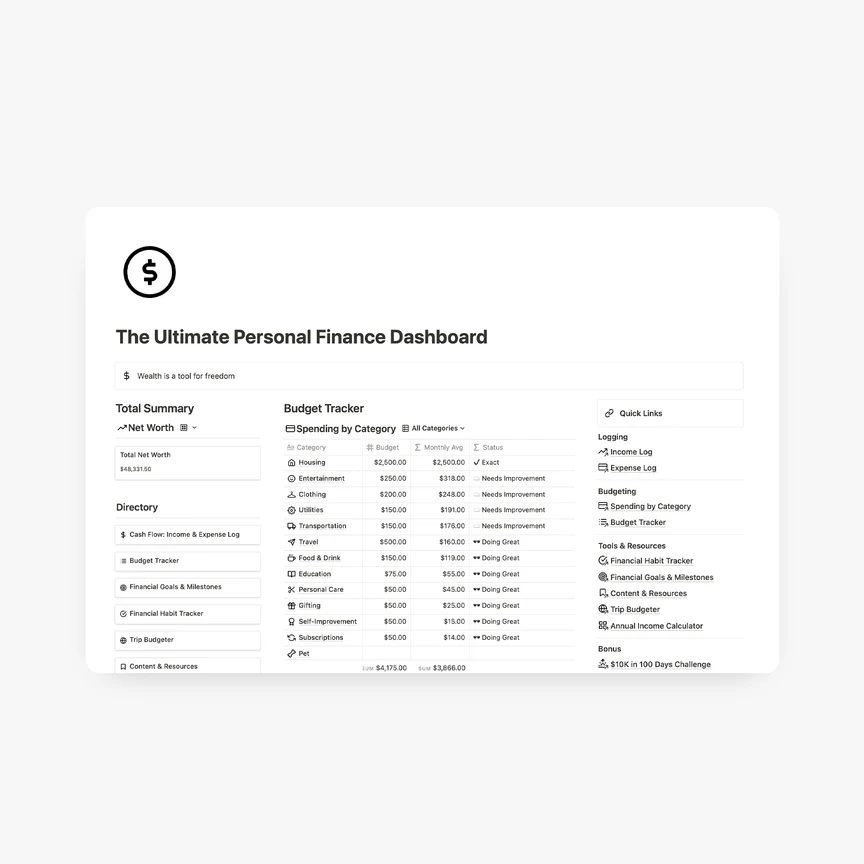
- Use Case: Comprehensive financial overview
- Key Features: Net worth tracking, spending trends, saving challenges
- Pros: Visually engaging, extensive tools
- Cons: Potentially overwhelming at first
My Take:
Gridfiti’s Ultimate Personal Finance Dashboard made budgeting… actually fun? The design is stunning—sleek, colorful, and motivating. I used it when I wanted a more engaging view of my finances and was blown away by how visual and interactive it felt. From a net worth calculator to savings challenges, this template turns budgeting into a personal game.
What I Liked:
- The savings challenge section (I used the $10K in 100 Days tracker) was incredibly motivating.
- I loved how the template grouped all your financial tools—budgeting, income, subscriptions, debt, and even a travel planner—into one workspace.
- It’s very plug-and-play friendly, especially for Notion users who prefer visual dashboards.
Challenges I Faced:
- There’s so much packed in here that if you’re not using all the features, it might feel cluttered.
- Takes a bit of time to learn the layout—especially if you’re coming from simpler budget tools.
Final Verdict:
This is perfect for visual thinkers and those who enjoy gamifying their financial journey. Ideal for individuals or couples who want an aesthetic yet powerful dashboard.
4. Finance Tracker & Budget Planner
by Notion Everything
- Use Case: Finance tracking with multi-currency support
- Key Features: Budget planning, recurring transactions
- Pros: Elegant design, comprehensive analytics
- Cons: Slight learning curve
My Take:
This one’s a polished powerhouse. I turned to it when I needed multi-currency support while juggling personal and freelance expenses. It’s elegant, modern, and handles everything from savings and subscriptions to goals and net worth—all in one dashboard.
What I Liked:
- It works well for international users. I used INR and USD side by side with no trouble.
- The recurring transaction section was great for my monthly software subscriptions and rent.
- There’s a strong emphasis on clarity, and I loved how goals and account balances are visualized.
Challenges I Faced:
- The navigation takes a while to get used to. If you’re not familiar with Notion relations, expect a short learning curve.
- No real-time tracking (obviously, because it’s Notion), so manual updates are essential.
Final Verdict:
This is a clean, comprehensive solution for users dealing with more than one currency or income stream. It’s powerful enough for advanced needs, yet still user-friendly.
5. Budget Tracker (Premium) by Easlo – ~$5
5.Budget Tracker (Premium)
by Easlo
- Use Case: Simplified monthly budgeting
- Key Features: Category budgets, progress indicators
- Pros: User-friendly, clear categorization
- Cons: Lacks advanced analytics
My Take:
Easlo’s premium Budget Tracker was one of the first paid templates I tried. For its price, it packs surprising value. I used it for a month when I wanted to track my spending categories without all the extra bells and whistles. It’s minimalist but efficient.
What I Liked:
- Clean interface with budget progress bars—great for visualizing category spending.
- Simple to set up and use, even if you’re new to Notion.
- Great documentation (as always with Easlo).
Challenges I Faced:
- It doesn’t have advanced reporting or forecasting features.
- More suitable for monthly tracking than long-term financial planning.
Final Verdict:
If you’re just starting your budgeting journey or prefer a lean system, this template nails the basics beautifully. For $5, it’s a no-brainer.
6.Financial Tracker
by Daniel Marthi
- Use Case: Detailed finance tracking
- Key Features: Income, expenses, savings, debt tracking
- Pros: Comprehensive detail, structured reports
- Cons: Requires diligent updates
My Take:
I used Daniel’s Financial Tracker during tax season to make sense of my income, savings, and expenses. It felt like a clean accounting book—clear, structured, and no-nonsense.
What I Liked:
- Breaks down income, expenses, savings, and debt separately.
- There’s a real emphasis on financial clarity, which helped me prep for yearly tax review.
- The reporting system helped me identify monthly overspending patterns.
Challenges I Faced:
- Doesn’t focus much on visuals or dashboards. If you like charts and graphs, you might miss them here.
- Manual input is required for every field—you’ve got to stay consistent.
Final Verdict:
Perfect if you want detailed financial logs and structured breakdowns. Best suited for individuals or freelancers who prefer a “ledger-style” tracking system.
7.Financial Dashboard
by Marius Andre
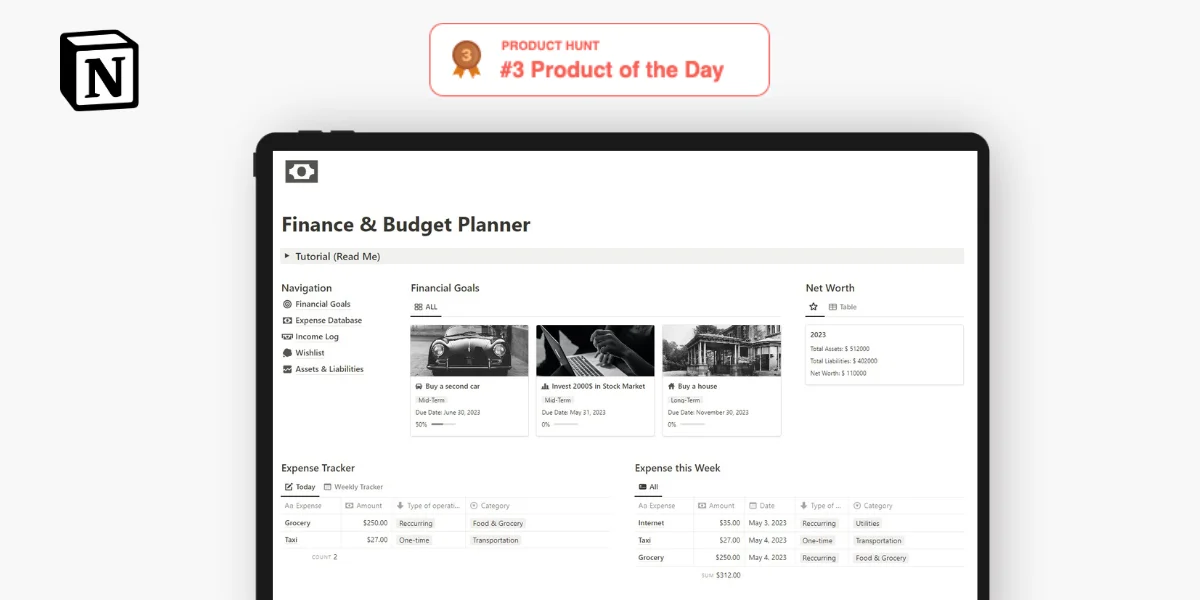
Use Case: Integrated budgeting and investment tracking
Key Features: Net worth overview, detailed analytics
Pros: Combines budgeting and investments
Cons: Basic investment tracking
My Take:
This template impressed me with its all-in-one approach to tracking spending, budgeting, and investments. I used it for a quarter while trying to get a handle on my investments and net worth—and it made a big difference.
What I Liked:
- Clean, professional UI with clear summary metrics.
- Investment tracking isn’t just an afterthought—it’s genuinely useful.
- Easy to customize, especially the monthly overview section.
Challenges I Faced:
- It’s not designed for live syncing with investment accounts—you’ll have to update values manually.
- Might be too much if you’re only budgeting and not investing.
Final Verdict:
A solid pick for those who want a complete view of both their spending and wealth-building efforts. Especially good for early investors or FIRE followers.
8.Annual Budget Planner
by Notionade

Use Case: Yearly budgeting and savings goals
Key Features: Annual tracking, custom event funds
Pros: Good for annual financial planning
Cons: Limited monthly details
My Take:
This template was perfect when I wanted to plan a full year ahead. It’s structured around annual goals and includes tools for planning events like vacations, birthdays, and big purchases.
What I Liked:
- I loved the “custom fund” feature for setting aside money for specific occasions.
- Having a bird’s-eye view of the whole year helped me stop last-minute overspending.
- Monthly breakdowns + yearly rollups = perfect combo.
Challenges I Faced:
- It’s not designed for day-to-day expense logging.
- Takes effort upfront to plan out the year, which might not suit spontaneous spenders.
Final Verdict:
Great for long-term planners and goal setters. If you’re the kind of person who uses a planner religiously, this is your financial equivalent.
9. Aesthetic Budget Planner
by Natalie

Use Case: Aesthetic and engaging personal budgeting
Key Features: Savings challenges, meme integrations
Pros: Fun, motivational
Cons: May be too casual for some
🔗 Get it on Gumroad
My Take:
This one was unexpectedly fun. Natalie adds memes and soft color schemes to make budgeting more approachable. I used it during a stressful work month and it honestly made financial planning feel like less of a chore.
What I Liked:
- Includes everything—income, expenses, subscriptions, savings challenges.
- The “envelope” savings method was easy to understand and motivating.
- It’s a whole vibe—makes you want to come back to update your numbers.
Challenges I Faced:
- Might feel too “cute” if you prefer minimalist or pro-style dashboards.
- No complex features like investments or net worth tracking.
Final Verdict:
If budgeting stresses you out, this light-hearted but complete template is a winner. Especially great for creatives and students.
10.Budget & Expense Tracker
by TNV Madhav

Use Case: Daily expense management
Key Features: Multiple account tracking, sleek dashboard
Pros: Attractive design, multi-account
Cons: Lacks long-term planning
My Take:
Madhav’s tracker is one of the most visually appealing templates I’ve used. I tried it while managing multiple bank accounts, and it helped keep everything organized—especially when logging expenses across cards, UPI, and cash.
What I Liked:
- The dashboard is clean and informative—think modern meets functional.
- I liked that you can categorize transactions by both account and platform (e.g. ICICI / Credit Card).
- Works well across mobile and desktop.
Challenges I Faced:
- Doesn’t have advanced goal tracking or forecasting.
- Focused more on spending than savings or investments.
Final Verdict:
Ideal if you want something beautiful and practical. Great for personal or household budgeting across multiple financial accounts.
11. Digital Budget Planner by NCL Design Co. – ~$12
🔗 Get it on Gumroad
My Take:
This one’s for those who love automation. I used NCL Design Co.’s Digital Budget Planner when I got tired of manually summarizing each month. What sold me? It automatically rolls up your expenses, gives you reminders for bills, and includes monthly financial to-dos. Felt like having a mini CFO.
What I Liked:
- The automation in monthly reports saved me time and energy.
- Built-in bill and subscription reminders kept me from missing payments.
- The layout is easy to navigate, and the design is super aesthetic.
Challenges I Faced:
- Setting up recurring items takes a little effort upfront.
- If you don’t follow through consistently, the automation won’t be as helpful.
Final Verdict:
If you want a planner that works for you (instead of the other way around), this one’s golden. Perfect for organized folks or those who forget to check their bills.
12. Optimized Budget Template
by Mohamed Adel
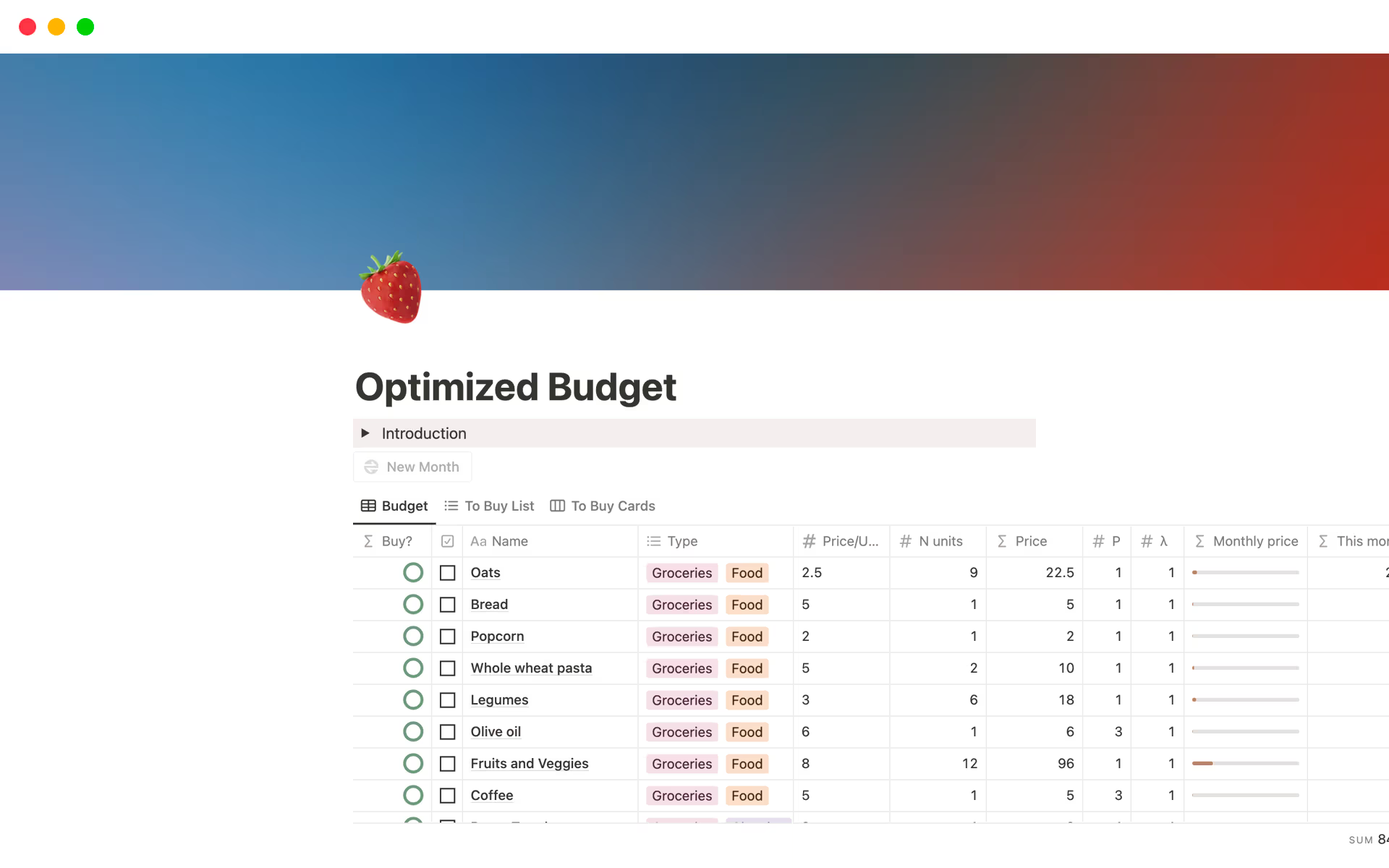
Use Case: Simplified budgeting in dark theme
Key Features: Single database, recurring reminders
Pros: Compact, visually appealing
Cons: Single database complexity
🔗 Get it on Gumroad
My Take:
I’m a sucker for a dark theme, and this one looks clean. I used it for a month just to test how well a one-database system could function, and honestly, it surprised me. It handles recurring bills, categories, and budgeting—all in one spot.
What I Liked:
- The design is modern and minimalist (bonus if you love dark mode).
- Recurring payments are easy to log and track.
- Simple UI means less jumping around pages.
Challenges I Faced:
- Since it’s one large database, things can get messy if you’re not familiar with filters.
- Not ideal for someone who prefers segmented dashboards.
Final Verdict:
Great value for money. A good pick for users who want something sleek and fast, without sacrificing core functionality.
13. A Financial Notion
Better Creating

Use Case: Personal and business finance management
Key Features: Income/expenditure tracking, profit & loss reports
Pros: Good for freelancers
Cons: Slightly more complex
My Take:
This one’s geared toward freelancers and small business owners. I used it while tracking both my content creation earnings and personal finances, and the separation of business vs. personal made it super useful.
What I Liked:
- Profit & Loss views for each month are a lifesaver during tax season.
- It’s structured, yet flexible—ideal for creators juggling side hustles.
- The design is practical without feeling overwhelming.
Challenges I Faced:
- If you only need personal budgeting, it might be overkill.
- You need to be diligent about tagging each transaction correctly (business vs. personal).
Final Verdict:
This is your go-to if you’re self-employed, freelancing, or running a side business. Saves you from toggling between apps or spreadsheets.
14. Personal Budget Template (Premium)
by Ratio

Use Case: Advanced spending analysis
Key Features: Spending insights, detailed analytics
Pros: Insightful and actionable
Cons: Mainly spending focused
🔗 Get it on Gumroad
My Take:
This premium version of Ratio’s budget template is all about insight. I started using it when I wanted to compare what I planned to spend vs. what I actually spent—and wow, did it open my eyes.
What I Liked:
- Visual comparison between “expected” vs “actual” spending.
- Helps highlight overspending habits you might not notice.
- Clean, simple design that’s easy to stick with.
Challenges I Faced:
- Requires consistent input of both budgeted and actual numbers.
- Doesn’t cover investment tracking or multiple accounts.
Final Verdict:
If your goal is to understand and optimize your spending behavior, this one is extremely effective. Think of it as your financial mirror.
15. Budget + Subscription Tracker
by Philipp Stelzel

Use Case: Budget and recurring subscription tracking
Key Features: Visual Kanban view, subscription management
Pros: Visual, combined tracking
Cons: Limited to subscriptions and expenses
🔗 Get it on Gumroad
My Take:
This template made me realize how much I was spending on random subscriptions. I grabbed it for its simplicity and got more value than expected.
What I Liked:
- The Kanban-style layout for subscriptions is genius.
- Lets you view your recurring costs by due date or category.
- The aesthetic design makes budgeting feel lighter.
Challenges I Faced:
- Doesn’t include savings or income tracking.
- More of a supplementary tool unless you only care about subscriptions.
Final Verdict:
Perfect for anyone who’s lost track of their recurring expenses. Pair this with a main budget tracker and you’re solid.
16. Notion Finance OS by The Notionist – ~$49
16. Notion Finance OS $49
by The Notionist

Use Case: Real-time financial management
Key Features: Advanced formula-driven insights
Pros: Real-time feedback, advanced
Cons: Complex formula management
My Take:
This is for Notion nerds (like me) who want a full-blown financial operating system. I loved how it tied together accounts, transactions, savings goals, and dashboards with smart formulas.
What I Liked:
- Real-time formulas calculate how much budget remains.
- Full account management, income/expense breakdown, and goal tracking.
- Very customizable and scalable as your finances grow.
Challenges I Faced:
- Advanced setup; not beginner-friendly.
- If you accidentally break a formula, troubleshooting can be a hassle.
Final Verdict:
If you love Notion and want to manage your money like a pro, this template’s a dream. Just be ready to roll up your sleeves.
17. Finance & Budget Planner
by Jordi Labs

Use Case: Financial goals and net worth tracking
Key Features: Net worth calculator, goal setting
Pros: Comprehensive, goal-oriented
Cons: Transition from free version required
My Take:
After using Jordi’s free version, I knew I had to try the premium upgrade—and I wasn’t disappointed. This one focuses heavily on goals, net worth tracking, and streamlining your entire money system.
What I Liked:
- Automatic net worth calculations and clean interface.
- Sidebar navigation makes jumping between sections fast and easy.
- Clear breakdowns of savings goals and spending.
Challenges I Faced:
- No investment tracking features.
- Data migration from the free version takes time.
Final Verdict:
A strong upgrade if you’re already a Jordi fan. It takes your budget from basic to goal-focused.
18. The Money OS
by Lucas Ostrowski
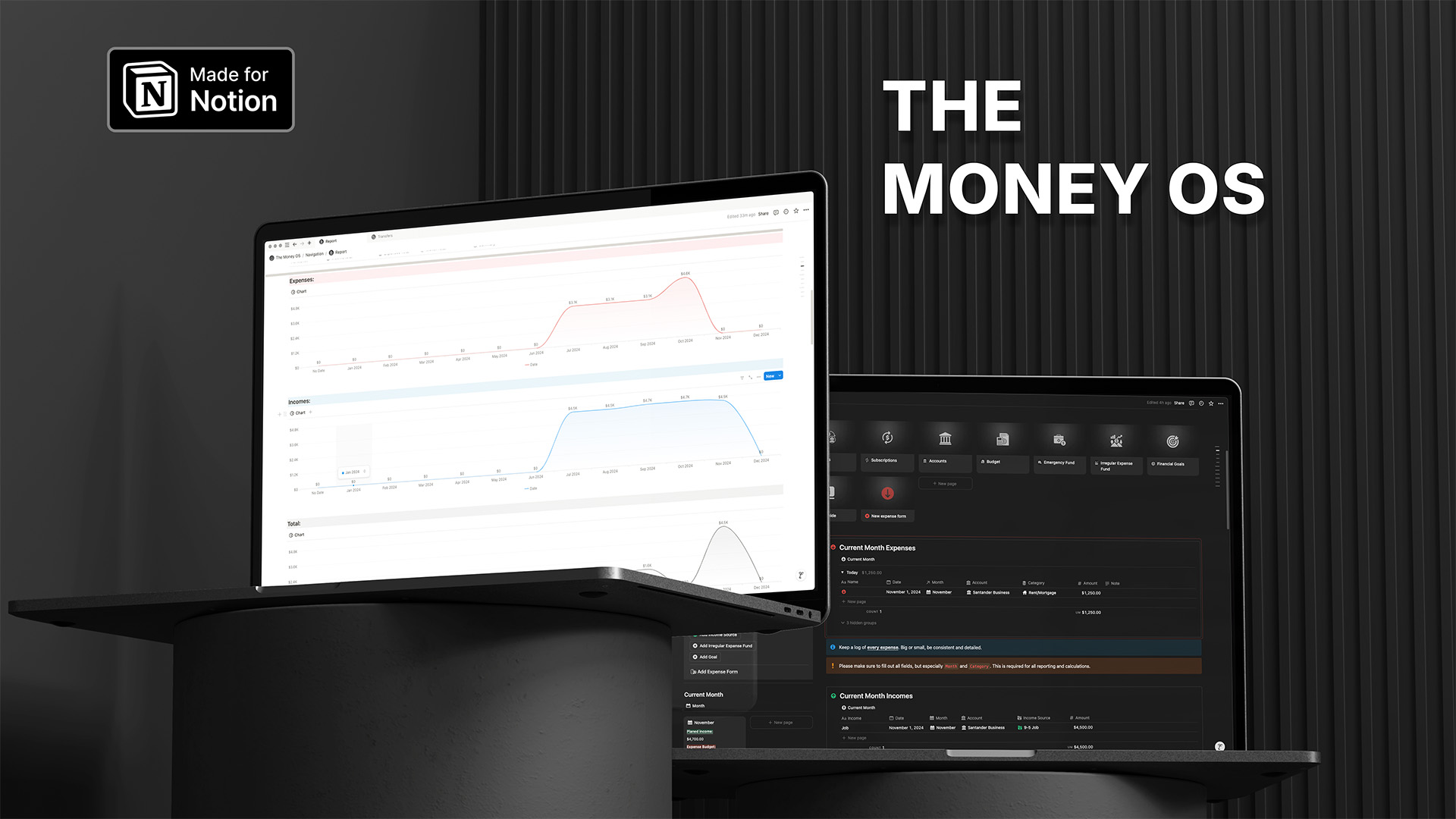
Use Case: Professional-level financial management
Key Features: Advanced analytics, extensive database
Pros: Powerful, comprehensive
Cons: High complexity and cost
My Take:
This one is intense—in the best way. The Money OS is a powerhouse for managing every financial detail. I used it to consolidate accounts, debt, savings, and spending into one monster dashboard.
What I Liked:
- Massive depth: net worth, FIRE goals, budgets, investments, and more.
- Clean navigation, excellent documentation.
- Designed by someone who gets financial workflows.
Challenges I Faced:
- It’s a commitment—setup time is significant.
- If you don’t use all the features, it might feel overwhelming.
Final Verdict:
Best suited for finance enthusiasts or spreadsheet lovers ready to graduate into Notion. Think of it as your own personal finance HQ.
19. Account, Finance & Invoice Manager
by Go Limitless

Use Case: Small business financial management
Key Features: Invoicing, project/client tracking
Pros: Excellent for freelancers and small businesses
Cons: Not suitable for personal-only budgeting
🔗 Get it on Gumroad
My Take:
As someone juggling freelance work and personal bills, I loved this one. It combines client management, invoicing, and budgeting all in one space—which saved me from using 3 different apps.
What I Liked:
- Invoice generation and tracking built into Notion? Yes, please.
- Client/project dashboards help keep freelance work organized.
- Built-in financial summary by project or client.
Challenges I Faced:
- Not ideal if you don’t have freelance/business income.
- Bit of a learning curve with all the interlinked databases.
Final Verdict:
Fantastic for solopreneurs or freelancers who want a one-stop finance + client management system.
20. Minimalist Finance Tracker
by Easlo
Use Case: Advanced personal finance with minimalist design
Key Features: Subscription tracking, bill splitting
Pros: Feature-rich, minimalist
Cons: Slightly expensive if bought separately
My Take:
When I wanted something clean but still feature-packed, I turned to Easlo’s Minimalist Finance Tracker. It has all the functionality—subscription tracking, bill splitting, renewal reminders—wrapped in a sleek interface.
What I Liked:
- Aesthetic layout with just the right amount of features.
- Perfect for couples or roommates who split expenses.
- Covers income, expenses, goals, and subscriptions in one view.
Challenges I Faced:
- Higher price if you’re only using it solo.
- Not ideal for business or multi-currency tracking.
Final Verdict:
If you like the minimalist vibe but want solid features, this one delivers. Ideal for everyday personal finance tracking with zero clutter.
1. Notion Budget Tracker by Modest Mitkus (Pathpages) – Free

- Use Case: Beginner-friendly personal budgeting
- Key Features: Minimalist expense tracking, budget limits by categories
- Pros: Simple and intuitive, beginner-friendly
- Cons: Lacks advanced analytics
My Take:
This is the template I recommend to anyone who’s just getting started with budgeting in Notion. Modest’s approach is super simple and approachable. I used it during a busy month when I didn’t want to overthink my finances—just log expenses and know if I was overspending.
What I Liked:
- You set a budget for each category and then just start logging. No fluff.
- The visual indicator tells you instantly if you’re over budget. Super handy.
- It’s also designed cleanly, so it doesn’t feel cluttered.
Challenges I Faced:
- No income tracking or savings goals—this is strictly for monitoring expenses.
- No analytics or fancy dashboards. But honestly, that’s the point.
Final Verdict:
A great minimalist tool if you just want to avoid overspending and keep things under control. If you’re easily overwhelmed, this template keeps it light and functional.
2. Monthly Budget Planner by Jordi Labs – Free
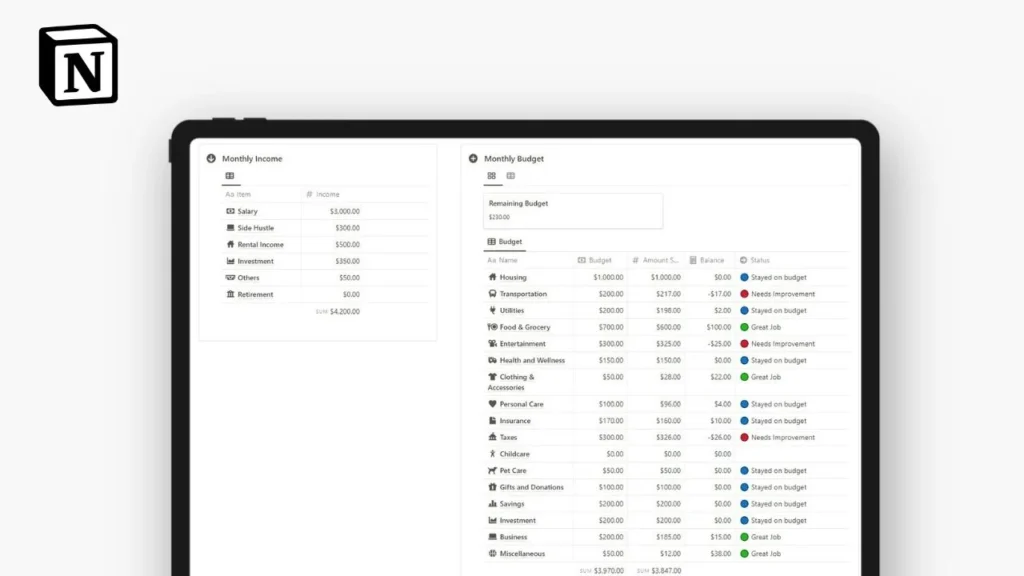
- Use Case: Monthly budgeting
- Key Features: Income and expense categorization, automatic calculations
- Pros: User-friendly, customizable
- Cons: No yearly tracking
My Take:
Jordi’s Monthly Budget Planner was my intro to categorized budgeting. I liked that I could plan how much to spend on groceries, entertainment, etc., and then log actual expenses to compare.
What I Liked:
- Auto-calculations make things smooth—budget remaining per category updates instantly.
- Clear layout with income, expenses, and monthly summaries.
- Customizable for your own categories and priorities.
Challenges I Faced:
- No built-in long-term planning (you have to duplicate it monthly).
- Doesn’t track savings goals or carry over balances.
Final Verdict:
If you’re focused on staying within a monthly plan and want a beginner-friendly layout, this is an excellent starting point. Especially good for students or first-time budgeters.
3. Simple Monthly Budget Tracker by Dave ✨ – Free
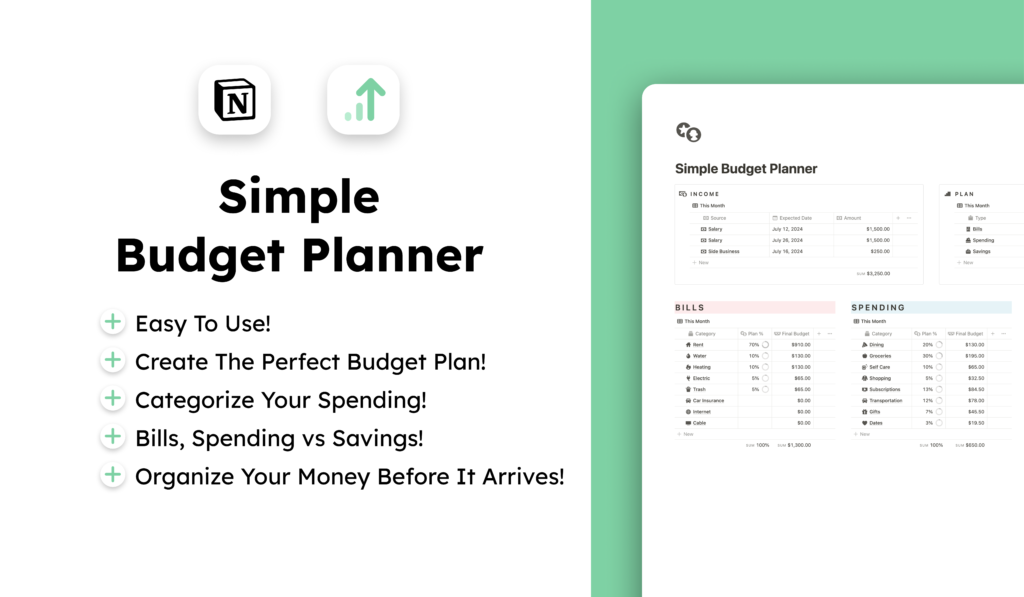
- Use Case: Monthly income and expense tracking
- Key Features: Minimalist design, budget indicators
- Pros: Easy setup, clear overview
- Cons: Basic visuals only
My Take:
Dave’s template is another go-to for Notion newcomers. I used it during a no-spend month challenge, and it helped me stay laser-focused without adding mental load.
What I Liked:
- Extremely easy to set up. Just add categories and start logging.
- Budget indicators show if you’re under/over budget by category.
- Great mobile view—helpful when I was tracking purchases on the go.
Challenges I Faced:
- Doesn’t support yearly roll-ups or multi-month views.
- It’s functional, but visually basic.
Final Verdict:
Great for a simple, no-fuss budgeting experience. If you want to build the habit of tracking expenses consistently, start here.
4. Simple Spending Tracker by Gridfiti – Free
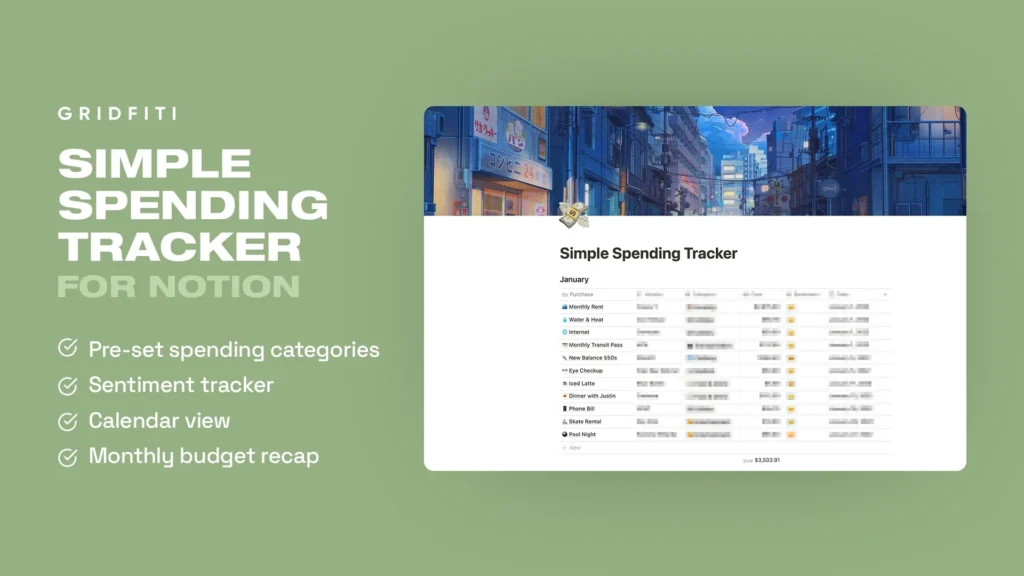
- Use Case: Mindful spending and daily journaling
- Key Features: Purchase sentiment tracking, calendar view
- Pros: Aesthetic design, encourages mindfulness
- Cons: Lacks income tracking
My Take:
This one’s perfect if you’re trying to understand why you spend, not just how much. I used it as a daily spending journal, and the “purchase sentiment” feature was game-changing.
What I Liked:
- Tracks how each purchase made you feel (happy, regretful, neutral).
- Aesthetic design that works well on mobile and desktop.
- Includes a calendar view and monthly recap.
Challenges I Faced:
- Doesn’t track income, so I paired it with another tracker.
- Not suited for full-on budgeting—more like a mindful expense journal.
Final Verdict:
A thoughtful tracker that helps curb emotional spending. Perfect for those working on financial habits or money mindset.
5. Aesthetic Finance Tracker by Nicole DeMarchi – Free
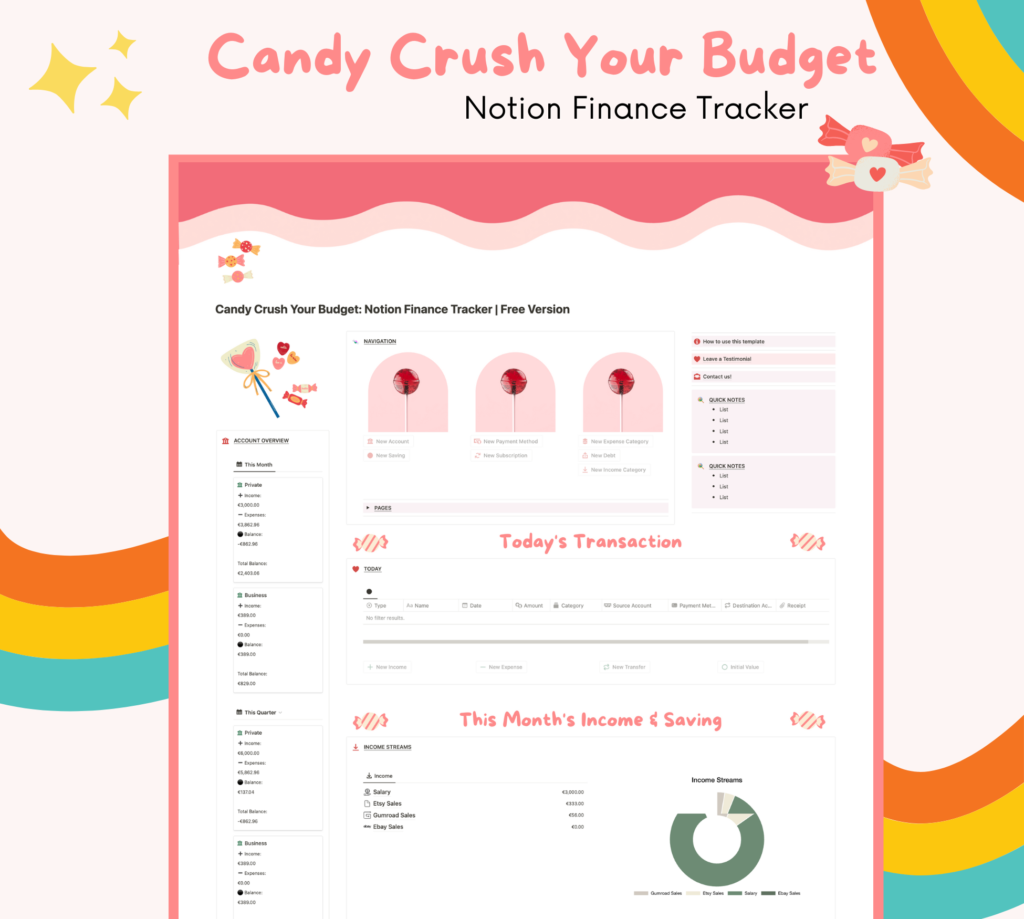
- Use Case: Personal finance tracking with fun themes
- Key Features: Expense and subscription tracker, visual dashboard
- Pros: Engaging design, comprehensive
- Cons: Premium features behind paywall
My Take:
I wanted something fun and cute to motivate me to budget regularly—this delivered. I used the “Candy” version, and honestly, it made tracking expenses feel less like a chore.
What I Liked:
- Comes in multiple aesthetic themes (Candy, Garden, etc.).
- Tracks expenses by payment method, subscriptions, and category.
- Mobile-friendly and really well-designed.
Challenges I Faced:
- Some features (like tax calculations or Jar system) are in the premium version.
- If you don’t like playful visuals, it might feel too quirky.
Final Verdict:
If visual appeal helps you stay consistent, this one is a treat. It turns budgeting into a playful but productive routine.
6. Minimalist Budget Planner by The Productivity Co. – Free

- Use Case: Personal multi-account budgeting
- Key Features: Multiple account tracking, responsive design
- Pros: Clean interface, mobile-friendly
- Cons: No built-in analytics
My Take:
Sometimes less is more, and this template lives by that rule. I used it when I wanted a no-clutter, everything-in-one-dashboard experience. Ideal for people who don’t want the distraction of charts or widgets.
What I Liked:
- Handles multiple accounts and categories.
- Super clean and distraction-free interface.
- Works great across mobile and desktop.
Challenges I Faced:
- No built-in graphs or summaries—you’ll need to build them if you want visuals.
- Requires some initial setup for categories and payees.
Final Verdict:
A solid option for those who want simplicity and structure. If you’re tired of bloated templates, this minimalist approach is refreshing.
7. Emotional Finance Tracker by Bodega Labs – Free (Freemium)

- Use Case: Improving money mindset
- Key Features: Expense reflections, emotional triggers tracking
- Pros: Interactive, focuses on behavioral change
- Cons: Advanced features in premium
My Take:
This template is a mix of finance and reflection. I used it for a month where I really wanted to fix my impulse spending—and wow, the emotional prompts before and after purchases made me pause and rethink.
What I Liked:
- Includes a spending reflection journal and sentiment analysis.
- Colorful, engaging themes with calendar views.
- Helps shift your mindset around money, not just your habits.
Challenges I Faced:
- More of a reflective tool than a full finance manager.
- Some advanced features are locked behind a paid version.
Final Verdict:
If emotional spending is your struggle, this is a gentle yet powerful tool. It’s like therapy for your wallet.
8. Notion Budget Tracker by KinaNotion – Free

- Use Case: Simple personal finance management
- Key Features: Basic expense and income tracking
- Pros: User-friendly, straightforward
- Cons: Minimal features
My Take:
I used KinaNotion’s tracker as a fast-and-easy finance log. It has just enough structure to be useful without any distractions. Think of it as your basic money logbook.
What I Liked:
- Separate income and expense tables with budget categories.
- Minimal learning curve—set it up in 10 minutes.
- Great for students or solo users.
Challenges I Faced:
- Doesn’t include goals, summaries, or visual reports.
- Monthly resets need to be done manually.
Final Verdict:
Perfect if you want something simple and stress-free. A great entry point into Notion budgeting.
9. Ultimate Budget Tracker by Chris – Free

- Use Case: General budgeting, multi-currency
- Key Features: Income/expense tracking, annual summaries
- Pros: Comprehensive, multi-currency support
- Cons: Minimal visuals
My Take:
This template surprised me—it’s free, but feels like a premium product. I used it while budgeting in both INR and USD and appreciated the multi-currency flexibility.
What I Liked:
- Supports any currency, and includes monthly + yearly views.
- Clear organization of income and expenses by category.
- Annual roll-up is super helpful for long-term tracking.
Challenges I Faced:
- No visuals or dashboards—this is more of a data-first layout.
- Some knowledge of Notion helps when customizing.
Final Verdict:
If you want a big-picture budget system with minimal design, this template delivers more than you’d expect from a freebie.
10. Budget Tracker (Minimal) by Notion Focus – Free
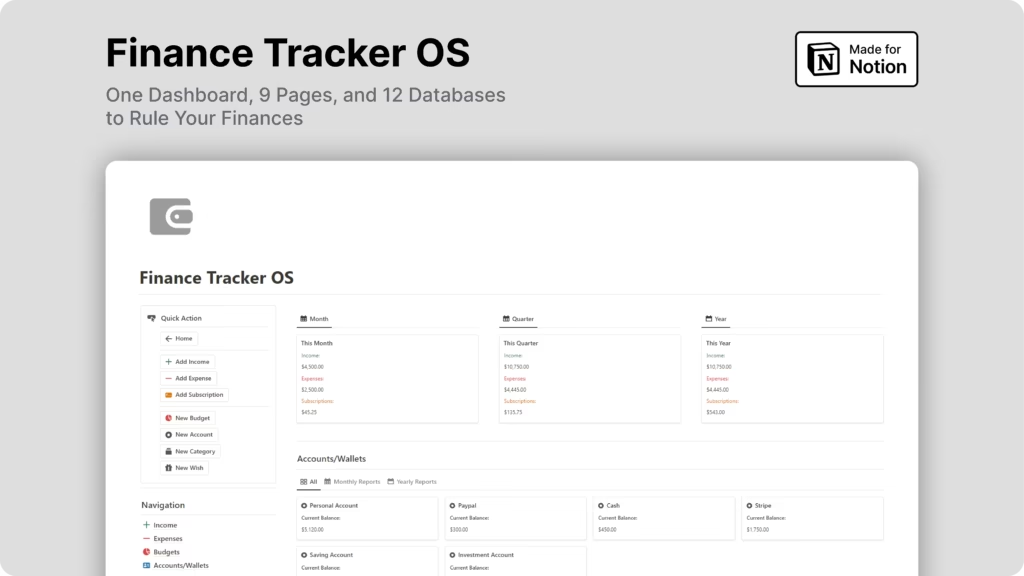
- Use Case: Simple household budgets
- Key Features: Automatic calculations, multiple currencies
- Pros: Simple, supports multiple currencies
- Cons: No detailed analytics
My Take:
This was my go-to for a side-by-side look at my monthly and yearly spending. It’s great if you like to zoom in and zoom out on your finances.
What I Liked:
- Auto-summing feature works flawlessly.
- Supports any currency and has a very clean layout.
- You can easily view expense trends across time.
Challenges I Faced:
- Doesn’t separate income and expenses—everything’s logged in the same place.
- No built-in savings goal tracker.
Final Verdict:
Ideal if you want a light, effective tool to track spending across multiple months. Great if you prefer a simple, streamlined system.
11. Quick Budgeting Template by PlannerNari – Free
🔗 Get it on Gumroad
- Use Case: Mobile-friendly budgeting
- Key Features: Quick-add buttons, monthly overview
- Pros: Optimized for mobile use
- Cons: Monthly focus only
My Take:
When I was trying to log expenses quickly on the go, this template came to the rescue. It’s super mobile-friendly and optimized for real-time tracking. I used it during a short trip and loved how fast I could log transactions.
What I Liked:
- One-click buttons to quickly add income or expenses.
- Monthly cash flow overview was clear and helpful.
- Clean, no-fluff interface that loads great on mobile.
Challenges I Faced:
- Doesn’t roll over month-to-month. Needs manual resets.
- No visuals or charts—purely transactional.
Final Verdict:
Ideal for mobile users or people who want to track spending in real-time. I still use it as a travel companion when budgeting away from home.
12. Travel Budget Tracker by Turtle Investor – Free
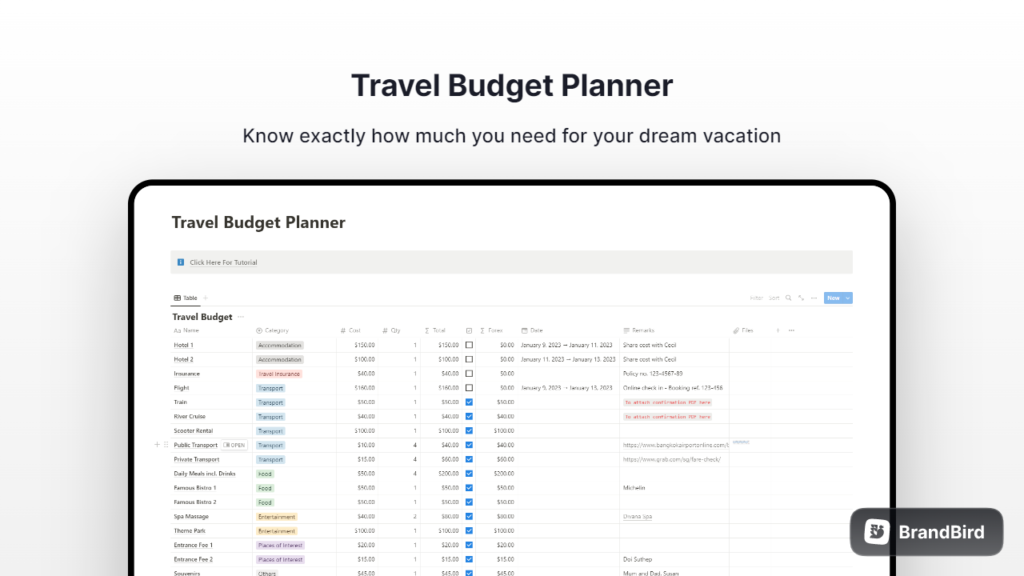
- Use Case: Vacation budgeting
- Key Features: Pre-loaded travel categories, currency converter
- Pros: Specialized for travel
- Cons: Limited to travel budgeting
My Take:
This was my favorite when planning my Meghalaya trip. It’s built for vacation budgeting with categories like flights, hotels, food, and activities already included.
What I Liked:
- Has pre-defined travel categories that save setup time.
- Currency converter section is perfect for international trips.
- Helps visualize how much you’ll spend before you go.
Challenges I Faced:
- Not useful for daily personal finance—strictly travel-focused.
- You’ll need to pair it with your main finance tracker if you travel often.
Final Verdict:
If you’ve got a trip coming up, this is a must-use. Helps keep travel costs realistic and avoid surprise expenses mid-vacation.
- Use Case: Vacation budgeting
- Key Features: Pre-loaded travel categories, currency converter
- Pros: Specialized for travel
- Cons: Limited to travel budgeting
13. “No More Impulse Spending” Budget by Braelyn (Notion for ADHD) – Free
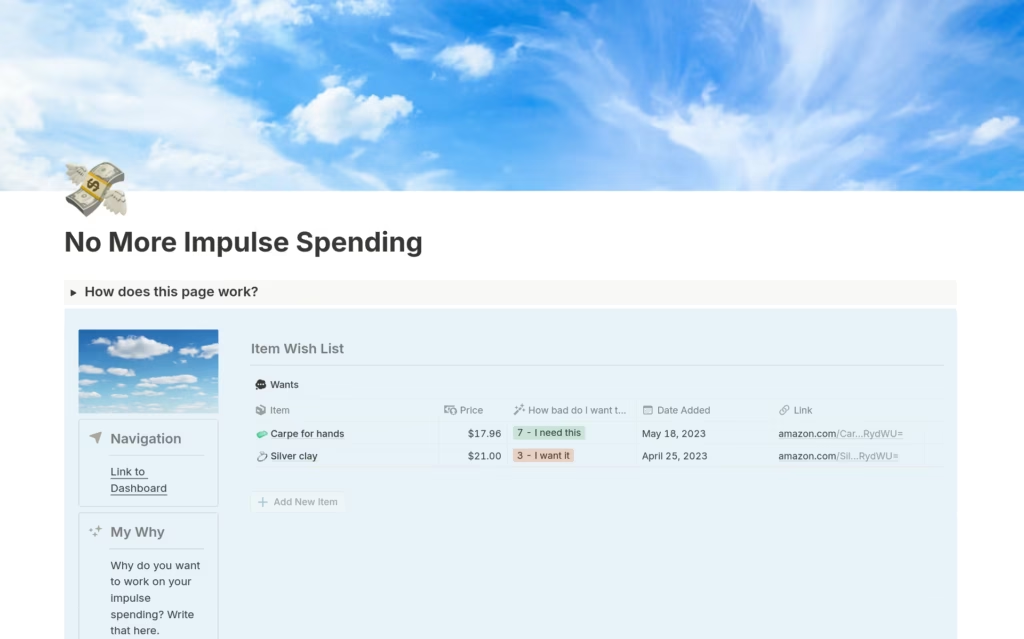
- Use Case: Reducing impulsive spending
- Key Features: Spending reflection prompts, savings tracker
- Pros: Encourages mindful spending
- Cons: Niche focus
My Take:
I tried this out for a month to work on emotional and impulsive spending—and it honestly felt like a mindset coach. The template gently nudges you to pause and reflect before hitting “buy.”
What I Liked:
- Pre-spend prompts help reduce unnecessary purchases.
- Encourages guilt-free reflection with a savings tracker and reward system.
- Tailored for neurodivergent users—but helpful for anyone.
Challenges I Faced:
- Might feel “extra” if you don’t struggle with impulse spending.
- Colorful design may not appeal to everyone.
Final Verdict:
If you struggle with spontaneous online orders (guilty ✋), this template can be a game changer. Feels supportive, not judgmental.
14. 50/30/20 Budget Template by Easlo – Free

- Use Case: Rule-based budgeting
- Key Features: Income allocation, automatic categorization
- Pros: Clear financial guidelines
- Cons: Rigid structure
My Take:
I used this one to test how well I was sticking to the 50/30/20 budgeting rule—and it was revealing. Easlo’s layout made it easy to see if my expenses aligned with that classic split.
What I Liked:
- Smart auto-categorization into Needs, Wants, Savings.
- Clean dashboard showing percentage breakdown.
- Great intro for people new to budgeting frameworks.
Challenges I Faced:
- Not flexible if your lifestyle doesn’t fit the 50/30/20 model.
- Doesn’t offer detailed category-level customization.
Final Verdict:
Perfect for budgeting beginners who want a clear framework. Helps build discipline without overcomplication.
15. Simple Expense Tracker by Lucas Ostrowski – Free

- Use Case: Daily expenses tracking
- Key Features: Expense categorization, visual charts
- Pros: Easy visualization
- Cons: Only expense-focused
My Take:
I used this when I wanted something visual but simple. It’s a clean and straightforward tracker that shows exactly where your money’s going, with built-in graphs.
What I Liked:
- Daily, monthly, and all-time views.
- Auto-generated bar charts for visual clarity.
- Minimalist but effective—great dark mode too!
Challenges I Faced:
- Focuses only on expenses—no income tracking.
- Needs monthly resets unless you tweak the filters.
Final Verdict:
If you want to see your spending trends without setting up formulas, this is your template. Still one of my go-to recommendations.
16. Personal Finance Dashboard by Notion (Official Gallery) – Free
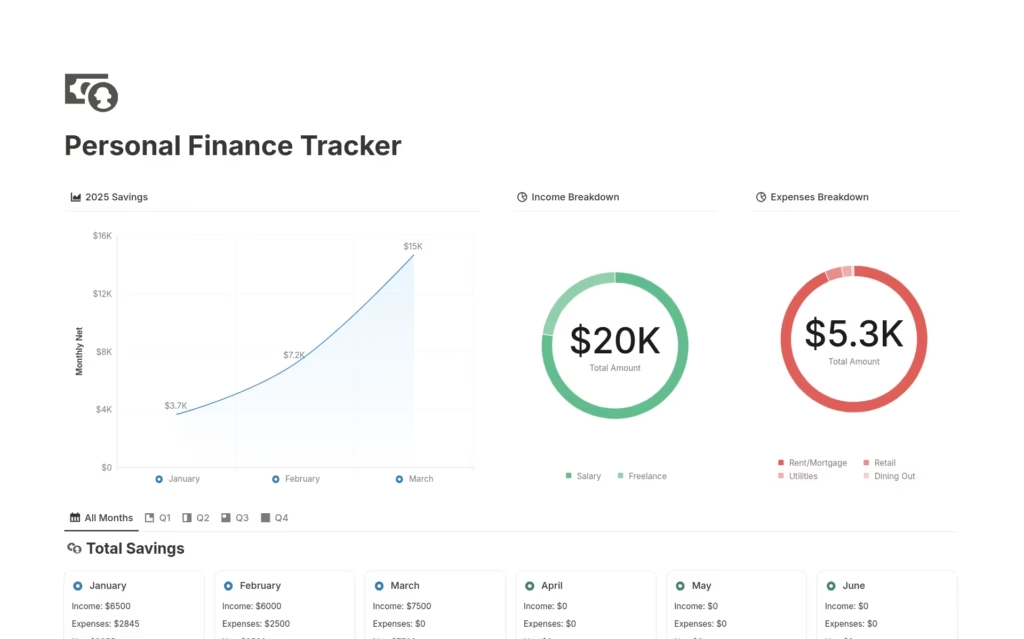
- Use Case: All-in-one finance tracking
- Key Features: Expense/income tracking, net worth calculator
- Pros: Comprehensive, free
- Cons: Complex for beginners
My Take:
This one is a beast. Built by the Notion team, it includes everything—income, expenses, goals, and net worth tracking. I used it for a few months when I wanted an all-in-one overview.
What I Liked:
- Net worth tracking with assets and liabilities.
- Income vs. expenses dashboard with visuals.
- Professional-grade without the price tag.
Challenges I Faced:
- Slightly complex setup for new users.
- You need to understand Notion relations for full customization.
Final Verdict:
The best free all-in-one system I’ve found. A bit advanced, but totally worth learning if you want comprehensive tracking.
17. Monthly Cashflow Manager by Michael – Free
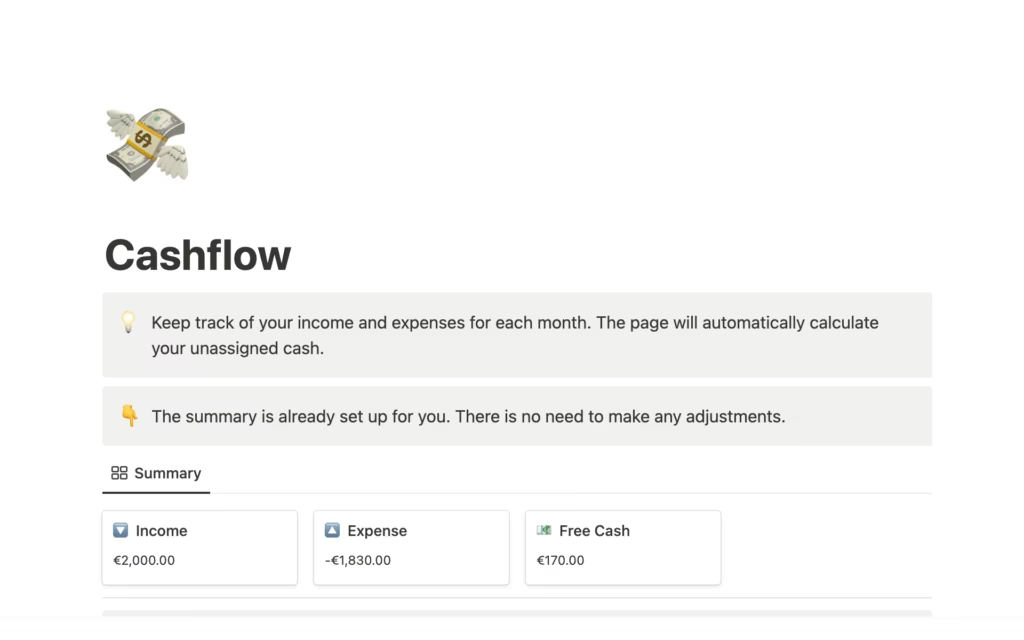
- Use Case: Monthly cashflow monitoring
- Key Features: Income allocation, month-end balances
- Pros: Straightforward cashflow view
- Cons: Minimal categorization
My Take:
This felt like a digital checkbook. I used it when I was focused on understanding cash flow: income in, expenses out, and what’s left at month’s end.
What I Liked:
- Simple format for tracking income allocation.
- End-of-month balance is clearly visible.
- Works great for household budgeting.
Challenges I Faced:
- Doesn’t categorize expenses into subtypes (like groceries or transport).
- More of a totals tracker than a budgeting tool.
Final Verdict:
Great for straightforward money management. Perfect if you want to know exactly where your cash stands each month—no fluff.
18. Budget Tracker (Detailed) by Gheorghe Listru – Free
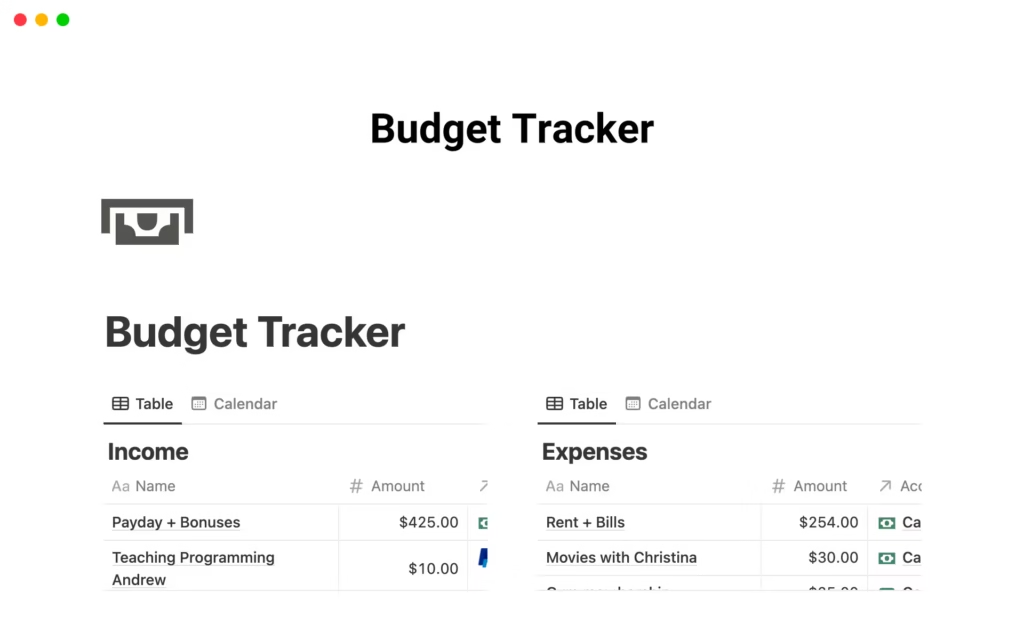
- Use Case: Detailed transaction logging
- Key Features: Rich categorization, multiple account management
- Pros: Comprehensive transaction tracking, detailed analytics
- Cons: Requires consistent manual data entry
My Take:
This one is for the detail-obsessed (me included). I used it during tax season when I wanted full control over every transaction—what account, what category, and what purpose.
What I Liked:
- Extensive property tagging: date, account, category, type.
- Great filters and views to analyze spending patterns.
- Supports multi-account tracking and category roll-ups.
Challenges I Faced:
- Very manual. You need to log every little detail.
- No summary dashboard unless you build it yourself.
Final Verdict:
A tracker for data nerds. If you want full visibility, it doesn’t get more granular than this.
19. Monthly Budget by Nick Lafferty – Free (Freemium)
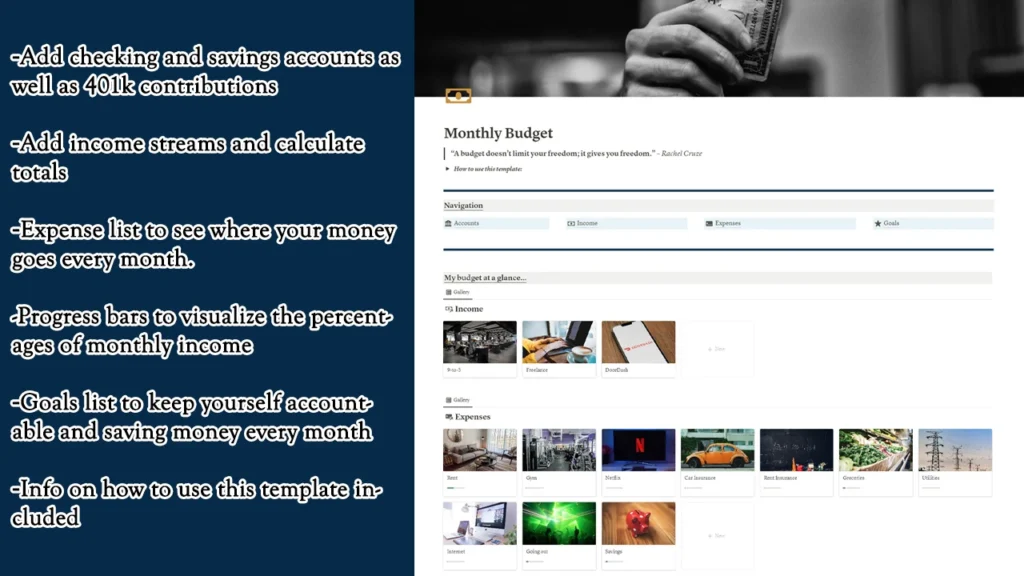
- Use Case: Personal budgeting with multiple income streams
- Key Features: Budget tracking, goal setting
- Pros: Good for tracking progress and financial goals
- Cons: Advanced features require paid upgrade
My Take:
This template helped me monitor income from multiple freelance clients. Even the free version lets you add multiple income streams, set monthly goals, and track your spending progress.
What I Liked:
- Budget progress tracker is super motivating.
- Simple design that’s easy to expand if needed.
- Good foundation for those with multiple income sources.
Challenges I Faced:
- Some useful features (account balancing, 401k, etc.) are behind a paywall.
- Not ideal for long-term planning.
Final Verdict:
Great monthly overview for freelancers or side hustlers. The free version is strong enough to be useful, and upgrading is optional.
20. Personal Budget Template by Ratio – Free

- Use Case: Analyzing spending behavior
- Key Features: Comparison between planned vs actual expenses
- Pros: Provides actionable insights into spending
- Cons: Focused primarily on spending analysis
My Take:
I tried this to get insight into my spending habits. Unlike other templates, it compares what you planned to spend with what you actually did—and the differences were eye-opening.
What I Liked:
- Planned vs. Actual budget comparison.
- Simple visuals that highlight overspending.
- Makes budgeting a strategic tool, not just a tracker.
Challenges I Faced:
- You have to input budgeted values manually.
- Doesn’t include net worth or investment sections.
Final Verdict:
Excellent for breaking bad habits and becoming intentional with money. Helps build a data-driven financial mindset
💬 Frequently Asked Questions (FAQ)
1. What is a Notion budget template?
A Notion budget template is a pre-built workspace inside Notion designed to help you track your income, expenses, savings, goals, and more. It saves you the time of building a budgeting system from scratch and allows you to customize your finances in a way that works for you.
2. Are Notion budget templates free?
Many great Notion budget templates are free, especially for basic budgeting needs. However, premium templates (usually priced between $5–$50) often offer advanced features like investment tracking, multi-currency support, subscription management, and automation.
3. What’s the best Notion template for beginners?
If you’re just getting started, try the Notion Budget Tracker by Modest Mitkus or the Simple Monthly Budget Tracker by Dave. These templates are clean, easy to set up, and perfect for building the habit of logging expenses without getting overwhelmed.
4.Can I use Notion for both personal and business finances?
Yes! Some templates like A Financial Notion by Better Creating and Account, Finance & Invoice Manager by Go Limitless are designed to help freelancers and business owners track both personal and professional finances in one place.
5. How do I choose the right template for me?
Think about your goals. If you want simplicity, go with a minimalist or visual template. If you’re managing multiple income streams, debts, or investments, a finance OS with more structure may be better. This list breaks down each option based on use case, so you can pick what fits your style.


